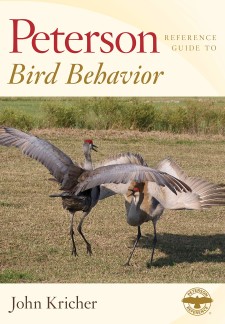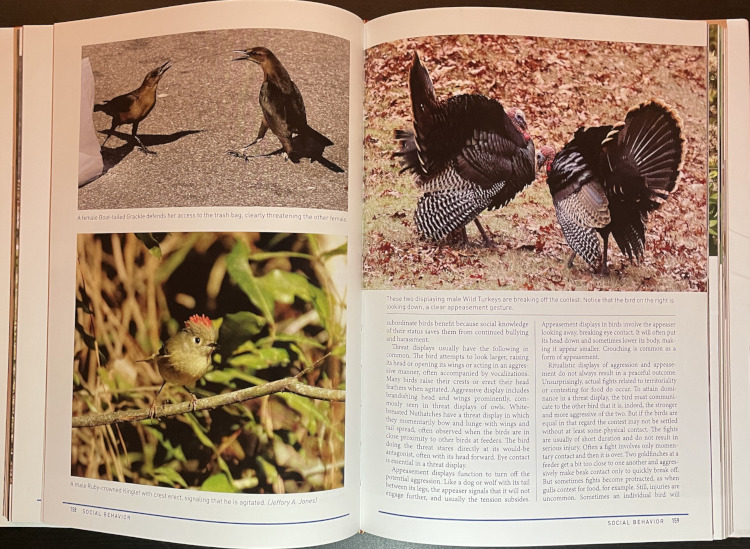Reviewed by Grant McCreary on February 18th, 2021.
One of the early entries in Houghton Mifflin’s superb Peterson Reference Guide series was Peterson Reference Guide to the Behavior of North American Mammals. That volume had me eagerly awaiting a companion volume for birds. After nine years, we finally have it with John Kricher’s Peterson Reference Guide to Bird Behavior.
In a series with volumes on such birderly topics as birding by impression, seawatching, and molt, the topic of behavior sticks out as one seemingly unrelated to bird identification. However, that is not the case, as behavior can be just as much a field mark as a patch of color. But besides that utilitarian reason for birders to pay attention to behavior, it’s worthwhile to look beyond what a bird is to what it is doing. Kricher puts it better than I could:
Bird identification is rich with behavioral field marks. Behavioral clues help identify birds as to species, but behavior also allows you to better understand the bird. Birds think. Their actions are overwhelmingly purposeful, not random. Birds are constantly making decisions-hundreds if not thousands of decisions daily. Behavior tells us about birds as living beings, not just as “things.”
Unlike Behavior of North American Mammals, this guide is not organized taxonomically. Instead, each chapter looks at a category of bird behavior, such as senses, vocalization, social behavior, territoriality, nesting, and migration. Clearly organized into sub-topics, each chapter is a short overview of the subject. Kricher pulls from many research studies and his own extensive experience, providing lots of examples using North American birds. Most importantly, he keeps things enjoyable to read and easy to understand.
This book’s organization makes it easy to pick up and read at virtually any point that you find of interest, but don’t be surprised if you find yourself continuing to read beyond what you had planned; there are so many fascinating things here. With such a wide variety of topics falling under the umbrella of bird behavior, and with new discoveries constantly being made, even widely readers can’t help but learn a great deal from this reference guide. I had a constant internal refrain of “huh, interesting” while reading it. Here are but a few examples:
- Do you know why pigeons bob their head while walking? It’s to give it a better view of its surroundings while walking. Interestingly, “Pigeons placed on a moving treadmill, where the side vision field remains the same, do not bob their heads.”
- I had been aware that albatrosses and other seabirds regularly consume plastic, but I hadn’t seen any good explanation why that is so. I assumed that it was a visual thing, that it must look like food. Actually, it’s more that it smells like food. Decomposing plastic emits the same type of chemicals as krill, their normal food.
- Ever thought it odd that warblers, kinglets, and other small birds search so hyperactively for food? Kricher makes an excellent point that these birds are small, which means they do not have much mass to move and thus “their seeming hyperactivity is not as energy costly as it might, at first glance, appear to be.”
The Peterson Reference Guide to Bird Behavior is perhaps the best book on the market for what it sets out to do. However, it is not quite the book that I was hoping for.
First, it includes topics beyond behavior. The chapter on Bird Diversity is, like the rest of the book, fascinating, but a large portion of that chapter deals with taxonomy, which does not seem especially related to bird behavior. The same goes for other subjects, like molt, and even the entire Feathers and Flight chapter which covers the function and coloration of feathers and the physiology of flight. These, as interesting as they are, seem out of place here, being more biology than behavior.
Second, this book is limited by a focus on North American birds, with global examples included only where necessary. While this makes it much more relevant for North American readers, it makes it correspondingly less so for international ones. Crucially, it also removes from scope some types of fascinating behavior, like that of honeyguides and bowerbirds.
Therefore, this guide’s use of space on non-behavioral subject matter and limited geographic focus precludes it from being a comprehensive reference guide to bird behavior worldwide. I thought that important to point out in case you are looking for just that. However, one of the primary tenets of book reviewing is to judge a book based on what it is, not on what you want it to be. And what this book is is an excellent overview of the behavior, along with some biology, of North American birds, perfect for birders in this region.
Like other entries in this series, Bird Behavior is well-illustrated with many wonderful photographs. Besides depicting behavior mentioned in the text, they add immensely to the pleasure of reading the book. However, the birds portrayed in the photos on the title pages and the full-page pictures at the end of the book are not identified. This won’t be an issue for most readers, as these are magnificent photos of common, well-known birds, but it’s just good practice.
Finally, Kricher ends with a References and Further Reading section. If any of these chapters particularly interest you, definitely check out his recommendations. Besides standard bibliographic information, he also provides some brief thoughts on some entries, making this section worth perusing for anyone looking for the next bird book to read.
Recommendation
Bird behavior is an endlessly fascinating topic, and Peterson Reference Guide to Bird Behavior is an excellent overview of the subject, with certain caveats. This should be one of the first books that North American birders read after learning the basics of bird identification and the craft of birding. What you learn here will greatly increase your appreciation for the birds you are watching. Those outside this region could also benefit from it, especially if you’d like to get a feel for the behavior of North American birds. But if you’d rather something more general in scope, or a book that includes “your” birds, then you should look elsewhere.
Disclosure: I get a small commission for purchases made through links in this post.
Buy from NHBS
(based in the U.K.)
Disclosure: The item reviewed here was a complementary review copy provided by the publisher. But the opinion expressed here is my own, it has not been influenced in any way.







 (1 votes, average: 4.00 out of 5)
(1 votes, average: 4.00 out of 5)
Comment